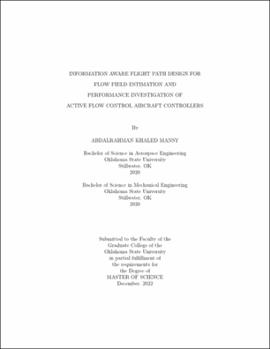| dc.contributor.advisor | Faruqe, Imraan | |
| dc.contributor.author | Mansy, Abdalrahman Khaled | |
| dc.date.accessioned | 2023-08-02T19:47:13Z | |
| dc.date.available | 2023-08-02T19:47:13Z | |
| dc.date.issued | 2022-12 | |
| dc.identifier.uri | https://hdl.handle.net/11244/338796 | |
| dc.description.abstract | This thesis discusses the feasibility and performance of implementing a COTS reciprocating piston compressor for a developed active flow control (AFC) actuation framework to quantify the aerospace-relevant performance ramifications of control architecture and compressor operational choices as well as the design and implementation of a systematic framework for specifying measurement trajectories for wind field structure system identification. | |
| dc.description.abstract | Three Active Flow Control architectures are studied under varying compressor operation schedules: supply volume metering (SVM), exit area metering (EAM), and a combined approach (VAM). The analysis framework in this study integrates internal pneumatic actuation and discharge dynamics, an experimentally-calibrated compressor pressure and thermal dynamics model, three feedback control architectures, and flight dynamics models. The framework is implemented in simulation to provide a user-friendly tool for linking AFC architecture choices to achievable flight trajectories. Actuator performance is evaluated using actuation time, output, compressor duty cycle, and specific energy consumption. Aircraft tracking performance is evaluated as usable time and slalom centerline deviation. The analysis indicates that exit area metering provides the best efficiency and run time with some structural drawbacks, while the combined approach provides the best flight-tracking performance at the expense of additional complexity. | |
| dc.description.abstract | This thesis also develops a systematic framework for specifying UAS-borne wind measurement trajectories based on information recovery. The framework quantifies information-richness in terms of wind field parameters and uses an initial flow structure estimate to construct a least squares optimization approach, including two alternative definitions of parameter information. The framework is implemented via dynamic programming within a flight dynamics and gust response simulator. The test cases include an isolated rotational (tornadic) flow structure and one embedded in a uniform wind field. The results indicate that an approach that optimizes based on observed flow gradients provides improved parameter estimate accuracy over one using only estimated flow structure gradients. | |
| dc.format | application/pdf | |
| dc.language | en_US | |
| dc.rights | Copyright is held by the author who has granted the Oklahoma State University Library the non-exclusive right to share this material in its institutional repository. Contact Digital Library Services at lib-dls@okstate.edu or 405-744-9161 for the permission policy on the use, reproduction or distribution of this material. | |
| dc.title | Information aware flight path design for flow field estimation and performance investigation of active flow control aircraft controllers | |
| dc.contributor.committeeMember | Arena, Andy | |
| dc.contributor.committeeMember | Paul, Ryan C | |
| osu.filename | Mansy_okstate_0664M_17981.pdf | |
| osu.accesstype | Open Access | |
| dc.type.genre | Thesis | |
| dc.type.material | Text | |
| dc.subject.keywords | active flow control | |
| dc.subject.keywords | estimation | |
| dc.subject.keywords | system identification | |
| thesis.degree.discipline | Mechanical and Aerospace Engineering | |
| thesis.degree.grantor | Oklahoma State University | |
